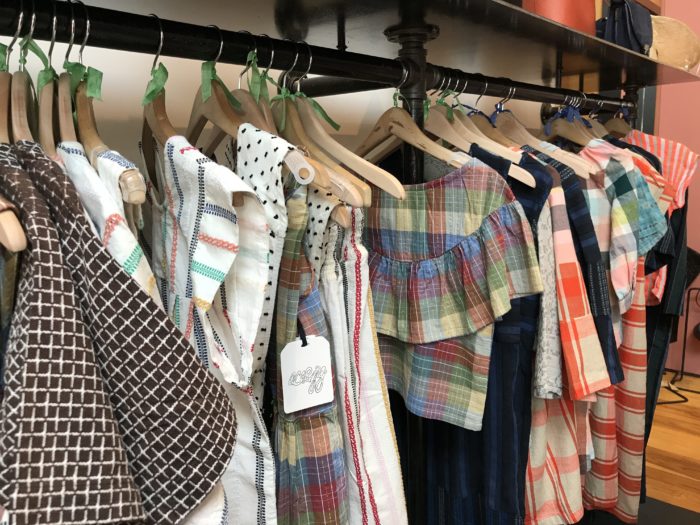On a recent Saturday afternoon, the new Fort Greene location of the upscale boutique Bird was almost at capacity. This was no surge of random shoppers, but a fan-club gathering. The star of the show was Ace & Jig, a Brooklyn-born brand that doesn’t just have customers, it has a community of believers who share in what the proprietors Cary Vaughan and Jenna Wilson call “a textile love story.”
At a time when low-priced, fast fashion from the likes of H&M and Topshop have grabbed a big part of the garment business, Ace & Jig has gone in the opposite direction. Their creations have been called “slow fashion,” made from richly textured fabric, woven in India, in limited quantities and eminently collectible.
The event at Bird was a combination sample sale and swap meet. In the front of the store, the sample sale offered discounted garments from past collections. In the back, an assistant created tags for all the swappers and then snapped Polaroid portraits of them to attach to each tag, so that whoever was interested in swapping for a particular item could locate its owner and start negotiating.
To facilitate the swaps, garments were marked with tags bearing the owners’ Polaroid portraits
On a table nearby, glasses of rosé, champagne, mimosas and San Pellegrino were perched next to plates of donuts by Dough. Vaughan was fulfilling her hostess duties, clad in a lace shirt, one of the Ace & Jig jumpsuits in the Chester pattern (white, off-white, black) and a matching off-white bag. She greeted participants and offered refreshments.
Wearing that outfit, coupled with flowing hair and a radiant complexion, Vaughan vaguely resembled a cult leader or a high priestess, and rightfully so. Ace & Jig, which she launched with Wilson in 2010, consists of collections of garments in timeless shapes all made from yarn-dye fabrics, which they design from scratch, anchored by the stripe as a recurring element. A family-run textile manufacturer produces the clothes in India.
Wendy Chu, who runs the blog Another Thread, almost entirely devoted to the brand
“Their fabrics are unique and individual, and designed by them. Every item feels incredibly special,” said Bird owner Jennifer Mankins, who has carried Ace & Jig for several years. “They are colorful, they are easy, great pieces. They are fashion but you don’t have to think too much about them.” The Ace & Jig founders, she added, “have this top-down, holistic approach, sort of like a wellness approach that we really respect and value.”
With 25 new designs per season, each fabric is around for one collection and, save for very rare exceptions, once it’s gone, it’s never going to be available again. This exclusivity fostered a very active online community of traders and swappers. (On Instagram, #aceandjig has more than 39,000 posts.) Fans scour the internet in search of pieces they missed out on, which are referred to as “unicorns,” a term that indicates both particular garments and fabric designs.
Julie, a Chicago-based knitter and a sewer attending the Bird event, was looking for a Haiku jacket in a Nightshade pattern. She has been obsessed with it ever since she started following the brand about a year ago, and spotted one at the swap event. Alas, it was not in her size.
While waiting in line for the dressing room, Leslie, a journalist, told of the legendary Oxblood fabric. “It’s a really flattering dark-reddish color,” she said. One dress in that color, the Gallery Dress from the Fall 2013 season, “originally sold for under $300 at retail but was acquired on eBay in 2016 for around $1,600,” according to The Business of Fashion.
As a business, Ace & Jig has grown at a steady pace, with revenue reportedly expected to reach $5 million in 2017. The brand has added an office in Portland, Ore., and sells its products online and through about 150 retailers.
The Ace & Jig obsession now transcends the borders of the New York area. “I have been haunted by a purchase I didn’t make!” Columbus-based user @cl_in_cbus told The Bridge in an email. “There was a boutique in Columbus that carried Ace & Jig, and they had one dress left (in my size!) on the sale rack for $90. These days I’ll happily plunk down $200+ for a piece I really love, but at that time it wasn’t in my budget. This is what we would call #aceandjigregrets!” The style, for the record, was the Bungalow Dress in Bangle Lattice in a size large.
To display their love of the brand, most of the participants at the swap meet wore at least one piece by Ace & Jig to the event: a kimono-like jacket over a laced frock; a pair of wide-leg pants in a colorful fabric called Mirage, paired with a casual black tank top.
On-site sewers lovingly repaired Ace & Jig items during the event
Several women actually wore the same dress, the Teasdale Dress in the Ivy fabric, a sleeveless, round-collared midi-length dress. One of them was Wendy Chu, who is so obsessed with Ace & Jig that she runs the blog Another Thread, almost entirely devoted to the brand, for which she tours stores to assess their Ace & Jig edits. She currently owns 150 pieces. “I tend to buy fabrics I really love or shapes that I really love,” she said. “If I like the fabric, I will try to buy it in as many shapes that look good on me.”
Yet these elaborately crafted fabrics can be delicate, so the presence of two on-site sewers was a welcome service at the Bird event. Keii Ikeda and Aris Suchinroj, sitting next to the entrance, mended tears in the dresses. Suchiniroj was making a side seam stronger; the fabric can be prone to loosening up. “So I am tightening just a little bit,” she said. “You have to hand-wash it,” Ikeda warned, as a general rule. A small price to pay for a cult-like item.
